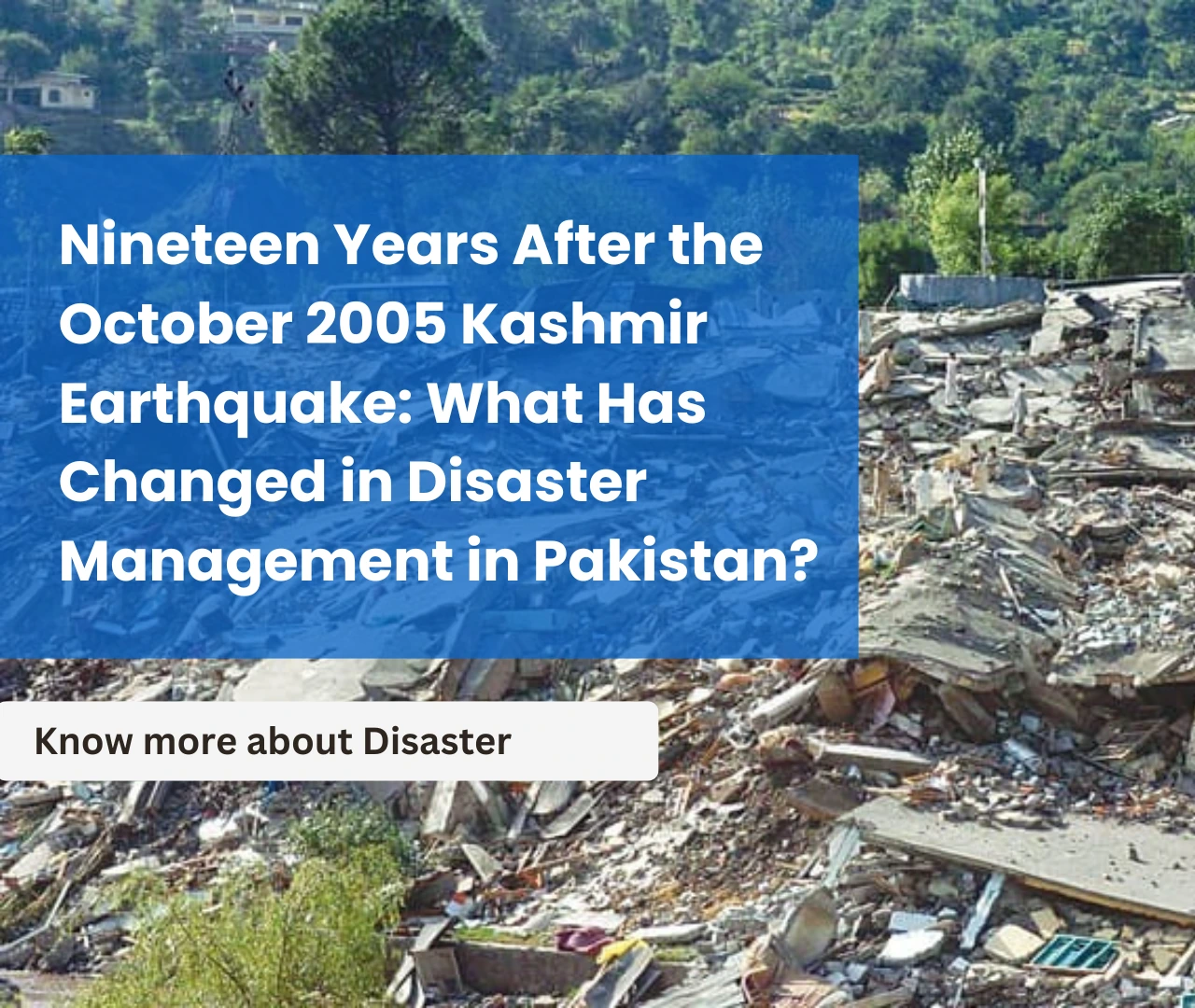The 8th October 2005 Kashmir earthquake was one of the most significant events in Pakistan’s history, fundamentally changing how disasters are perceived and managed in the country. Nineteen years ago, a massive 7.6 magnitude earthquake struck Pakistan’s Kashmir region, claiming over 73,000 lives and displacing millions. The earthquake exposed critical vulnerabilities in Pakistan’s disaster management apparatus, prompting a paradigm shift in the country’s approach to disaster preparedness, response and recovery.
The October 2005 earthquake marked a pivotal moment for disaster management in Pakistan. Prior to this event, disaster management efforts were primarily reactive, focusing on addressing floods, with limited attention given to other potential threats like earthquakes. The earthquake’s devastating impact lead to significant changes across institutional, the levels of governance and the introduction of new legislation and policies. It was around the same time that other South Asian countries, following the 2004 Indian Ocean Tsunami, were also revamping their disaster management systems.
Reforms and Initiatives
Despite the government’s efforts to revamp disaster management in Pakistan by taking the opportunity with both hands, the effectiveness of these initiatives and measures over the past nineteen years has been mixed. The earthquake’s devastating impact led to significant changes across institutional the levels of governance and the introduction of new legislation and policies.
1. Creation of legal cover through the National Disaster Management Ordinance (2006) and later the NDM Act (2010):
The NDM Act was a critical step in formalizing Pakistan’s disaster management framework. It served as the foundational legal document that led to the establishment of the National Disaster Management Authority (NDMA) and clearly outlined its roles, responsibilities, and functions at the national level. The ordinance also mandated the creation of Provincial Disaster Management Authorities (PDMAs) and District Disaster Management Authorities (DDMAs), ensuring localized responses to emergencies.
2. Establishment of the Earthquake Reconstruction and Rehabilitation Authority (ERRA) (2005):
The first of its kind, ERRA was established immediately after the earthquake to oversee reconstruction efforts and coordinate with national and international stakeholders. ERRA’s mandate was to lead, coordinate, and manage large-scale reconstruction of damaged infrastructure, homes, and rehabilitation efforts in the aftermath of the disaster. Its owner-driven housing reconstruction approach was relatively successful and paved the way for future housing reconstruction programs in Pakistan and other regions. The improved versions with some common similarities can be seen in the housing reconstruction in the Sindh province after the 2022 super floods.
However, the recovery process was uneven, with some areas receiving more attention and resources than others. Remote or hard-to-reach areas were often left behind, resulting in disparities in recovery progress. ERRA, which was never assigned a set end date, still operates in some capacity. Over its long tenure, ERRA faced criticism for a lack of transparency in fund allocation and use. Civil society and donors raised serious concerns about how the funds were distributed, and allegations of mismanagement led to a loss of public trust. The lack of community participation in key decision-making processes persisted in later disasters, diminishing local ownership of recovery processes.
Reconstruction projects under ERRA were considerably delayed, primarily due to bureaucratic hurdles, logistical challenges, and slow decision-making. Despite subsequent disasters being larger in magnitude and affecting more people, the experiment of establishing a dedicated recovery and reconstruction authority was not repeated.
The recovery and reconstruction authorities established after the 2004 Indian Ocean tsunami, such as the Reconstruction and Development Agency (RADA) in Sri Lanka, the Tsunami Rehabilitation Programme (TRP) in India, and the National Disaster Management Centre (NDMC) in the Maldives, faced similar challenges with mixed success. This highlights that reconstruction after a mega disaster has its own unique difficulties, and Pakistan is not immune to these challenges either.
3. Creation of a National-Level Disaster Management Authority (NDMA) (2007):
NDMA, again the first of its kind in Pakistan, was established as the national-level body responsible for coordinating disaster response efforts across the country. Since its inception, NDMA has played a key role as the apex federal authority in formulating disaster management policies, mobilizing resources, and implementing disaster risk reduction (DRR) strategies.
Over the years, NDMA has effectively responded to both natural and human-made disasters, including the Covid-19 pandemic. It has also played a leading role in setting up early warning systems and coordinating with national and provincial departments to issue timely alerts and manage disaster response efforts. NDMA has made significant improvements in data collection and the development of early warning systems. These advancements have proven invaluable in subsequent disaster response and recovery efforts. Improved data collection allowed for better identification of affected people and facilitated quicker early relief and verification during housing recovery and reconstruction. The early warning systems also enhanced Pakistan’s ability to dispatch timely warnings to provincial and district authorities to prepare for disasters.
4. The National Disaster Risk Management Framework (NDRMF) (2007) – Shifting the paradigm from a reactive to a proactive approach:
Despite the goal of transitioning from a reactive to a proactive approach through the National Disaster Risk Management Framework (NDRMF), Pakistan’s disaster management approach remains largely reactive. Proactive measures are primarily limited to issuing early warnings about extreme weather and don’t necessarily result in community-wide preparation and mobilisation. Strengthening disaster preparedness, risk reduction, and response capabilities on the ground is necessary to ensure a more resilient and adaptive disaster management system across the country.
Communities in districts Thatta and Mirpurkhas in Sindh province, affected in 2010 floods, were again impacted in 2011 and 2022 floods. It highlights that these communities are trapped in a vicious cycle of vulnerability and lacking proactive preparedness and community resilience-building measures. Additionally, while the framework outlined roles and responsibilities for various stakeholders, including communities and NGOs, affected communities are still seldom included in decision-making processes. Most decisions regarding key aspects of recovery and reconstruction continue to come from national and provincial authorities.
Over the past nearly two decades, the role of NGOs and civil society organizations (CSOs) has not streamlined effectively, despite time and again playing a significant part in all phases of the disaster management cycle. The state’s policies toward NGOs and CSOs are inconsistent, with frequent policy shifts creating uncertainty in both local and international NGO sectors. Another area where Pakistan has failed to capitalize is in organizing and training volunteers at the district level. Despite the high levels of altruism and social capital in society, this potential remains untapped due to a lack of structured training and organization under a single framework for disaster response. In cases where district disaster management authorities lack capacity and skills, trained NGO staff and CSO volunteers can play a larger role in all disaster management phases. Their inclusion could significantly strengthen the proactive approach to disaster management in Pakistan.
5. Extending disaster management roles to provincial and district levels (2007-2009):
The goal of decentralizing disaster management to provincial and district levels has only been partially achieved. While Provincial Disaster Management Authorities (PDMAs) are functioning, district-level authorities are neither adequately trained nor equipped with the resources to decentralize disaster response efforts or provide tailored responses to local needs. This has hindered local-level preparedness and response, which could directly engage communities and local NGOs and CSOs for more effective disaster management. District authorities also lack dedicated trained staff and proper communication and coordination mechanisms.
Local governments have never been fully engaged in disaster management, and this role has been further sidelined in climate change adaptation plans and recovery frameworks prepared by international consultants. Provincial governments seem reluctant to pass resources and authority to local governments across Pakistan. Without the active involvement of elected local governments, disaster management efforts will continue to lag behind.
Whereas in India, with greater state autonomy, the regional disaster management authorities were able to establish a more effective local presence, as demonstrated during the 2018 Kerala floods. The role of the Kerala State Disaster Management Authority (KSDMA) was widely appreciated by both local and international stakeholders during response and recovery phases.
6. Revamping Pakistan’s Building Codes and Seismic Zoning after the 2005 Kashmir earthquake:
Significant changes were made in designing earthquake-resilient buildings and infrastructure following the 2005 Kashmir earthquake. The Building Code of Pakistan (BCP Seismic Provisions-2007) and the Seismic Zoning Map of Pakistan (2007) provided detailed guidelines for designing and constructing earthquake-resistant structures based on seismic zones.
However, in reality, outside of major cities, the implementation of building codes and seismic zoning maps remains a continuous struggle for building control authorities. Proper enforcement of building codes would not only create more resilient infrastructure but also help regulate the housing and construction industries at large.
7. Enhancing Coordination with International Stakeholders through the United Nations’ Cluster Approach:
The October 2005 Kashmir earthquake provided Pakistan with a pivotal opportunity to enhance international cooperation and coordination with international stakeholders, including the United Nations.
The 2005 Kashmir earthquake witnessed the largest disaster response in Pakistan’s history, with armed forces from multiple countries and UN agencies actively participating in rescue and relief activities for several days. It led to stronger partnerships and improved resource mobilization, laying the foundation for more effective disaster management strategies in the future. The UN Cluster Approach was first implemented in Pakistan following the 2005 earthquake, significantly improving disaster response coordination. The cluster approach was also evident in subsequent disasters, including the 2010 super floods and the 2022 floods for better streamlined humanitarian efforts.
Conclusion
The 2005 Kashmir earthquake served as a catalyst for transformative change in Pakistan’s disaster management landscape. However, the initiatives and progress made since then have been repeatedly tested. Major challenges arose during the 2010 and 2011 super floods, and more recently, the 2022 super-floods stretched Pakistan’s disaster management system to its limits. Despite advancements, significant challenges persist that are hindering Pakistan’s proactive approach to disaster management. Resource constraints continue to limit funding, and enhancing institutional capacity at the provincial and local levels remains a pressing need. Public awareness and sustained community engagement are critical, while climate change introduces new risks that require adaptation. Additionally, ensuring transparency and accountability is vital for maintaining public trust in disaster management efforts.
Recently, Pakistan’s finance minister, Muhammad Aurangzeb, admitted during a talk at the Woodrow Wilson Center that the pledges made by the international community after the 2022 super floods did not meet their targets. He explained that most of the funds were project-based, and unfortunately, “as a country, we do not do a good job in terms of coming up with projects for which the international community will fund. The right projects, in terms of not only their structure but also the monitoring and reporting mechanisms.”
This highlights that Pakistan still lacks key aspects of disaster management, such as proposing projects with active community engagement and meeting the expectations of affected communities and donors. This, in many ways, sums up Pakistan’s post-October 2005 Kashmir earthquake disaster management era.



